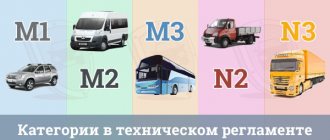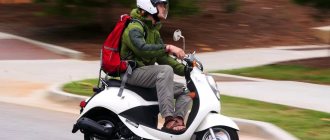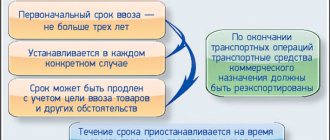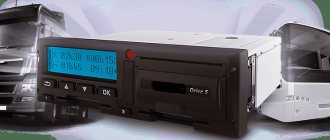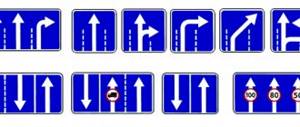AutoYurait.rf / Registration and accounting
Back
Published: November 22, 2018
Reading time: 16 min
0
853
Classification of vehicles on the territory of the Russian Federation is carried out in accordance with the Decision of the Customs Union Commission dated December 09, 2011 N 877 “On the adoption of the technical regulations of the Customs Union “On the safety of wheeled vehicles” (TR CU 018/2011). This regulation provides for the division of cars into categories, which have a letter designation: L, M, N, O.
- L - motor vehicles Mopeds, motorbikes, mokikis
- Motorcycles, scooters, tricycles
- Quadricycles
- Cars
Category "Lx"
Category “L” is usually divided according to the following criteria:
- “L1” is a two-wheeled vehicle that does not exceed 50 kilometers per hour. When an internal combustion engine is installed, its volume should not be more than 50 cm3. And when the electric motor is installed, its volume should not be more than 4 kW;
- "L2" is a three-wheeled vehicle that accelerates to no more than 50 kilometers per hour. With an installed internal combustion engine of no more than 50 cm3 or an electric motor of no more than 4 kW. These categories include mopeds and motorbikes. It's quite easy to differentiate between them;
- “L3” - vehicles with a maximum permitted speed of over 50 kilometers per hour with any engine installed;
- “L4” is a vehicle with wheels symmetrical to the transport plane. The maximum speed is more than 50 kilometers per hour, and the engine capacity is over 50 cm3;
- "L5" is a symmetrical vehicle that accelerates over 50 kilometers per hour. The engine capacity is more than 50 cm3;
- “L6” is a four-wheeled vehicle weighing no more than 350 kilograms. The mass of the battery is not taken into account. Transport should not exceed a speed of 50 kilometers per hour. In this case, the power of the internal combustion engine should not be more than 50 cm3, and the power of the electric motor should not be more than 4 kW;
- “L7” – other four-wheeled vehicles not included in the L6 category, weighing no more than 400 kilograms. For cargo vehicles 550 kilograms without battery. The engine capacity should not be more than 15 kW.
Categories M and N in vehicle classification
In modern Russia, in the process of assessing the technical condition of cars of any brand and category, it is now necessary to take into account the recommendations set out in a special regulatory document. We are talking about a technical regulation developed by the Customs Union and approving the basic principles of wheeled transport safety. Accessing this document for the first time often raises many questions among motorists.
The fact is that the regulations classify vehicles on the roads of our country in a special way. Its systematization is very different from the typology familiar to the Russian driver, which he memorized while familiarizing himself with the Traffic Rules. In particular, the most disagreement is observed regarding the newly created categories M and N.
Public transport (category M)
Technical regulations include a wide variety of vehicles in this class of vehicles: buses, specialized passenger transport, passenger cars, trolleybuses and some other objects. According to the official definition, the category includes all vehicles with 4 or more wheels, the main purpose of which is to transport people.
This classification is as follows:
- M1 are passenger cars that transport people and have up to 9 seats in the cabin (including the driver's).
- M2 is a vehicle that transports passengers, has a maximum weight of 5 tons and has more than 8 seats (without the driver’s seat).
- M3 is a large passenger vehicle (weighing from 5 tons), inside of which there are at least 8 places to accommodate transported people.
Freight transport (category N)
This class of equipment is represented by vehicles and their chassis designed for transporting various goods: finished products, materials, raw materials, etc. For the convenience of systematizing cars within this subsection, the developers of the regulations took the mass of the vehicle as the main classification criterion. This is what they ended up with:
- N1 includes all goods vehicles with a maximum weight of 3.5 tonnes.
- N2 includes vehicles and their chassis, provided that they are used for the transport of goods and demonstrate a maximum technically permissible weight ranging from 3.5 tons to 12 tons.
- N3 is represented by equipment that also transports cargo, but is characterized by a mass of 12 tons or more.
Correspondence of the categories of regulations to the table of vehicles from the traffic rules
To make it easier for motorists to navigate the new classification, experts suggest remembering that car classes N2 and N3 correspond to domestic category C, the term N1 means category B (trucks), the unusual class M1 includes vehicles of category B (cars and trucks), and M2-M3 hides category D cars.
Category "Mx"
Category M includes vehicles that allow the transportation of citizens. They are separated using the following:
- “M1” - the number of passenger seats is no more than eight. Usually this category is in greatest demand among citizens;
- “M2” - the number of passenger seats is more than 8, and the total weight does not exceed 5 tons;
- “M3” - the number of passenger seats is more than 8, and the total weight exceeds 5 tons.
The “M1” category includes ordinary passenger cars, which almost every family owns. The categories “M2” and “M3” designate trolleybuses or buses, which are divided depending on their weight. If it is less than 5 tone, then “M2”, and if more, then “M3”.
N - trucks
N1 - small trucks with a technically permissible maximum weight of no more than < 3.5 tons. For example, the well-known Gazelle belongs to this type.
N2 - trucks with a technically permissible maximum weight of more than > 3.5 tons , but not more than < 12 tons. This includes the so-called “five-ton trucks,” for example IVECO.
N3 - large trucks intended for the transport of goods, having a technically permissible maximum weight of more than > 12 tons. An example is large four-axle dump trucks.
A vehicle with no more than eight seats, excluding the driver's seat, intended for the carriage of passengers and goods, belongs to the category:
- M1, if the product of the number of passengers provided for by the design by the conditional mass of one passenger (68 kg) exceeds the estimated mass of cargo transported simultaneously with passengers;
- N if this condition is not met.
More on the topic: When do you need a category for a passenger trailer?
A vehicle designed for the transport of passengers and goods, having, in addition to the driver's seat, more than eight seats, belongs to category M.
Equipment and installations located on special vehicles (truck cranes, vehicles equipped with lifts with working platforms, tow trucks, etc.) are considered cargo.
Correspondence of vehicle categories and rights
Drivers often try to find out what category of license they need to have to drive a particular vehicle.
- to drive a passenger vehicle of category "M1" you will need the designation "B". Citizens need this category of license to drive a car every day. It is important to know that the “M1” category does not include trucks that fall under the “B” designation on their license;
- You can drive vehicles of categories “M2” and “M3” with a driver’s license with the designation “D”;
- vehicles falling under category “N1” can be driven with the common designation “B” on the driver’s license;
- to operate cars “N2” and “N3” you need category “C”;
- driving a car with a trailer weighing no more than 750 kilograms is possible with the usual category “B”;
- and for the categories “O1”, “O2”, “O3” the designations “E” to “B”, “E” to “C” and “E” to “D” on the license are suitable;
- To drive a vehicle of category “L1” - “L2”, you need category “M” on your driver’s license;
- You can drive a vehicle of category “L3” - “L5” with the designation “A”;
- You can legally drive a vehicle “L6” - “L7” if you own category “B1”.
When choosing your vehicle, be sure to check whether you have the ability to drive it. You can do this by looking at the designations that are on your driver’s license. If your category does not allow you to drive a certain vehicle, then its operation in the future may lead to the deprivation of your driver's license. Given such a serious punishment, we need to take this moment extremely seriously. Remember, you can also receive a punishment if you transfer your vehicle to a citizen whose category of rights does not allow him to drive this car.
What categories of road transport are there?
In accordance with the current traffic regulations, a road vehicle is considered to be cars that have such dimensional parameters as a height of up to 4 meters from the road level, a length of up to 12 meters for a bus, trolleybus, truck, a length of up to 15-18 meters for articulated buses and trolleybuses , width up to 2.6 meters for vehicles equipped with an isothermal body, width up to 2.63 meters for timber trucks, width up to 2.55 meters for other types of road transport, length of a road train up to 20 meters. The technical regulations of the Customs Union describe 4 main categories - L, M, N and O. The first category includes exclusively motorized vehicles of 7 types. The correspondence of the subcategory to a specific type of transport is reflected in the table below.
Table - Types of vehicles of category L
| Category | Type of road transport |
| L1 | Mopeds, motorbikes |
| L2 | Three wheel scooters |
| L3 | Motorcycles, scooters, tricycles |
| L4 | Three-wheeled motorcycles with wheels asymmetrically located relative to the longitudinal plane |
| L5 | Three-wheeled motorcycles with wheels symmetrically located with respect to the longitudinal plane |
| L6 | Quadricycles weighing up to 350 kg |
| L7 | Quadricycles weighing up to 550 kg |
According to the Technical Regulations of the Customs Union TR CU 018/2011 “On the safety of wheeled vehicles”
Among other requirements for motor vehicles of this category, it is worth noting the limitation in the maximum permissible design speed (up to 50 km/h). In addition, the engine displacement should not exceed 50 cm³. As for the compliance of the categories of road transport with the type of driver's license, motor vehicles correspond to categories M (L1-L2), A (L3-L5) and B1 (L6-L7).
Vehicle category M usually includes passenger vehicles whose total weight is 5000 kg or less. The most common option is M1. This category includes all passenger cars without exception. M2 is represented by trolleybuses, buses and other vehicles intended exclusively for passenger transportation. To be included in this category, a road vehicle must have more than 8 seats. The total weight of such a vehicle should not exceed 5000 kg. But the M3 includes the same road transport, but with a maximum permissible weight of more than 5000 kg.
In the vehicle category N, only freight road transport is presented. Category N is divided into 3 subspecies - N1, N2 and N3. In the first case, this marking designates road vehicles used for transporting goods whose maximum weight does not exceed 3500 kg. Trucks with a maximum weight of up to 12,000 kg are usually classified as N2. Finally, the third category includes cargo vehicles whose technical capabilities allow the transportation of goods with a total weight of over 12,000 kg.
The last category of road transport O includes trailers and semi-trailers with different maximum permissible weights. Thus, O1 is represented by trailers whose weight does not exceed 750 kg. O2 includes trailers whose technical characteristics allow transporting loads up to 3500 kg. O3 usually includes trailers with a maximum permissible weight of 10,000 kg. The last 4th category includes trailers weighing over 10,000 kg.
Motor vehicles
Mopeds, motorbikes, mokikis
Category L1 - Two-wheeled vehicles whose maximum design speed does not exceed 50 km/h and characterized by:
- in the case of an internal combustion engine - with an engine displacement not exceeding 50 cm 3, or
- in the case of an electric motor - rated maximum power in continuous load mode, not exceeding 4 kW.
Category L2 - Three-wheeled vehicles with any wheel arrangement, the maximum design speed of which does not exceed 50 km/h, and characterized by:
- in the case of an internal combustion engine with forced ignition - an engine displacement not exceeding 50 cm 3, or
- in the case of another type of internal combustion engine - a maximum effective power not exceeding 4 kW, or
- in the case of an electric motor - rated maximum power in continuous load mode, not exceeding 4 kW.
With scooters the situation is quite simple:
- If the scooter has 2 wheels, then it belongs to category L1.
- If the scooter has 3 wheels, then it belongs to category L2.
Thus, categories L1-L2 correspond to motor vehicles, which require a driver’s license of category M to drive.
Motorcycles, scooters, tricycles
Category L3 - Two-wheeled vehicles whose engine displacement (in the case of an internal combustion engine) exceeds 50 cm 3 (or) the maximum design speed (for any engine) exceeds 50 km/h.
Category L4 - Three-wheeled vehicles with wheels asymmetrical with respect to the median longitudinal plane, the engine displacement (in the case of an internal combustion engine) exceeds 50 cm 3 and (or) the maximum design speed (for any engine) exceeds 50 km/h.
Category L5 - Three-wheeled vehicles with wheels symmetrical with respect to the median longitudinal plane of the vehicle, the engine displacement (in the case of an internal combustion engine) exceeds 50 cm 3 and (or) the maximum design speed (for any engine) exceeds 50 km/ h.
If the distance between the centers of the contact patches with the road surface of the wheels of one axle is less than 460 mm, such vehicles belong to category L3.
CATEGORY O – TRAILERS AND SEMI-TRAILERS
Category O includes trailers and semi-trailers for vehicles of categories L, M, N. Like other road users, trailers require regular technical inspection, which is similar in its requirements to the maintenance rules for cars.
O1 – trailers, the technically permissible maximum weight of which is not more than 0.75 tons.
O2 – trailers whose technically permissible maximum weight is over 0.75 tons, but not more than 3.5 tons.
Vehicles of categories O1 and O2 are used together with passenger cars and motorcycles. The following maintenance rules apply to passenger trailers lighter than 3.5 tons:
- Maintenance is carried out every six months if the trailer (semi-trailer) is used for transporting dangerous goods;
- annual technical inspection for trailers over 7 years old;
- every twenty-four months (2 years), if the trailer is older than 3 years;
- not required in the first three years of operation, including the year of manufacture;
- technical inspection is not required if the owner of a passenger trailer weighing up to 3.5 tons is an individual (technical inspection is carried out solely at the request of the owner to obtain insurance).
O3 – trailers whose technically permissible maximum weight is over 3.5 tons, but not more than 10 tons.
O4 – trailers with a technically permissible maximum weight of more than 10 tons.
Trailers (semi-trailers) of categories O3 and O4 are considered cargo (for trucks) and are subject to mandatory technical inspection:
- every six months if the trailer (semi-trailer) is used for transporting dangerous goods;
- annually for trailers over 7 years old;
- every twenty-four months (2 years), if the trailer is older than 3 years;
- not required for the first three years of operation, including the year of manufacture.
Category L
Group L includes vehicles with the following characteristics:
category L1 - two-wheeled vehicles with a speed of no more than 50 km/h, an engine with a volume of up to 50 cubic meters. cm, electric motor with power up to 4 kW;
L2 - three-wheeled vehicles, wheel arrangement - any, speed no more than 50 km/h, engine capacity up to 50 cubic meters. cm, electric motor with power up to 4 kW.
The most popular vehicles of group L are mopeds, scooters, ATVs, tricycles, and motorbikes.
